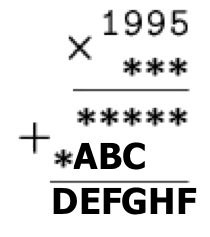Problems
In the rebus below, replace the letters with numbers such that the same numbers are represented with the same letter. The asterisks can be replaced with any numbers such that the equations hold.

An explanation of the notation used: the unknown numbers in the third and fourth rows are the results of multiplying 1995 by each digit of the number in the second row, respectively. These third and fourth rows are added together to get the total result of the multiplication \(1995 \times ***\), which is the number in the fifth row. This is an example of a “long multiplication table”.
Which five-digit numbers are there more of: ones that are not divisible by 5 or those with neither the first nor the second digit on the left being a five?
Alex laid out an example of an addition of numbers from cards with numbers on them and then swapped two cards. As you can see, the equality has been violated. Which cards did Alex rearrange?

Solve the problem: \(AX \times UX = 2001\). Both \(X\) stand for the same digit, but \(A\), \(U\) and \(X\) are all different single digits.
The number \(A\) is positive, \(B\) is negative, and \(C\) is zero. What is the sign of the number \(AB + AC + BC\)?
There are \(n\) integers. Prove that among them either there are several numbers whose sum is divisible by \(n\) or there is one number divisible by \(n\) itself.
a) A 1 or a 0 is placed on each vertex of a cube. The sum of the 4 adjacent vertices is written on each face of the cube. Is it possible for each of the numbers written on the faces to be different?
b) The same question, but if 1 and \(-1\) are used instead.
The digits of a 3 digit number \(A\) were written in reverse order and this is the number \(B\). Is it possible to find a value of \(A\) such that the sum of \(A\) and \(B\) has only odd numbers as its digits?
Let \(x\) be a 2 digit number. Let \(A\), \(B\) be the first (tens) and second (units) digits of \(x\), respectively. Suppose \(A\) is twice as large as \(B\). If we add the square of \(A\) to \(x\) then we get the square of a certain whole number. Find the value of \(x\).
A student did not notice the multiplication sign between two three-digit numbers and wrote one six-digit number, which turned out to be exactly seven times their product. Determine these numbers.